
A conventional marketing approach will focus on generating sales qualified leads. But that’s an incomplete approach if you’re a SaaS company.
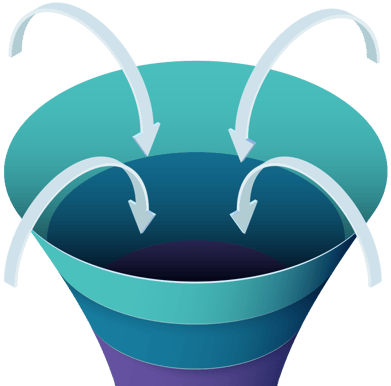
Because revenue is realized over an extended period of time, SaaS and other recurring-revenue businesses are fundamentally different.
Your marketing efforts need to reflect that difference by supporting the entire sales lifecycle, not just acquisition.
To put it another way: If you want to achieve hockey stick growth, you must do more than consistently grow your subscriber base:
These imperatives demand that you understand—and implement—a complete SaaS marketing approach.
A SaaS company has to market differently. That’s because realities like your SaaS sales cycle and recurring revenue model have to be interwoven into a unique marketing approach.
And that approach does not look like conventional marketing.
While a conventional marketing approach might stress how important the alignment of sales and marketing is, the product and customer success components (or their equivalents) often remain in silos.
To understand why that is, let’s establish a few principles....
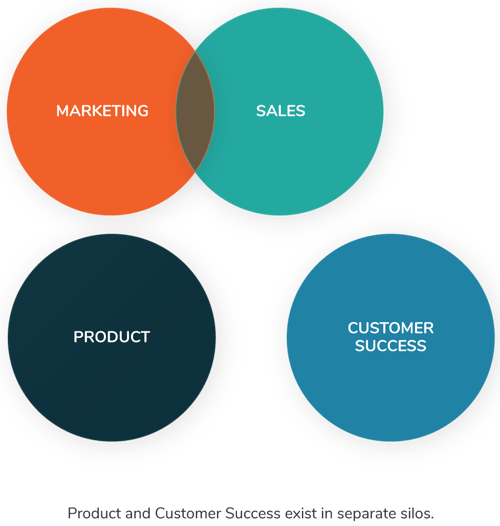
SaaS products are created to solve a real problem. If you’ve already confirmed your product/market fit, then you know that your SaaS fulfills a real market need and quenches a real inner motivation thirst.
The product/market fit concept is often attributed to startup guru and software engineer Marc Andreessen.
He puts it this way: “Product/market fit means being in a good market with a product that can satisfy that market.”
Andreessen also asserts that the life of a company can be divided in two: before and after product/market fit.
After your product/market fit is confirmed, you now know your product is inherently customer-centric.
But you must continue to understand the needs of your customers and foresee future ones.
As you move into further stages, you’ll need to keep conducting research that enables ongoing delivery of your value proposition.
A customer-centric approach is essential for building successful products. And provided that your approach to building products remains customer-centric, then you can unleash other key functions of your SaaS company.
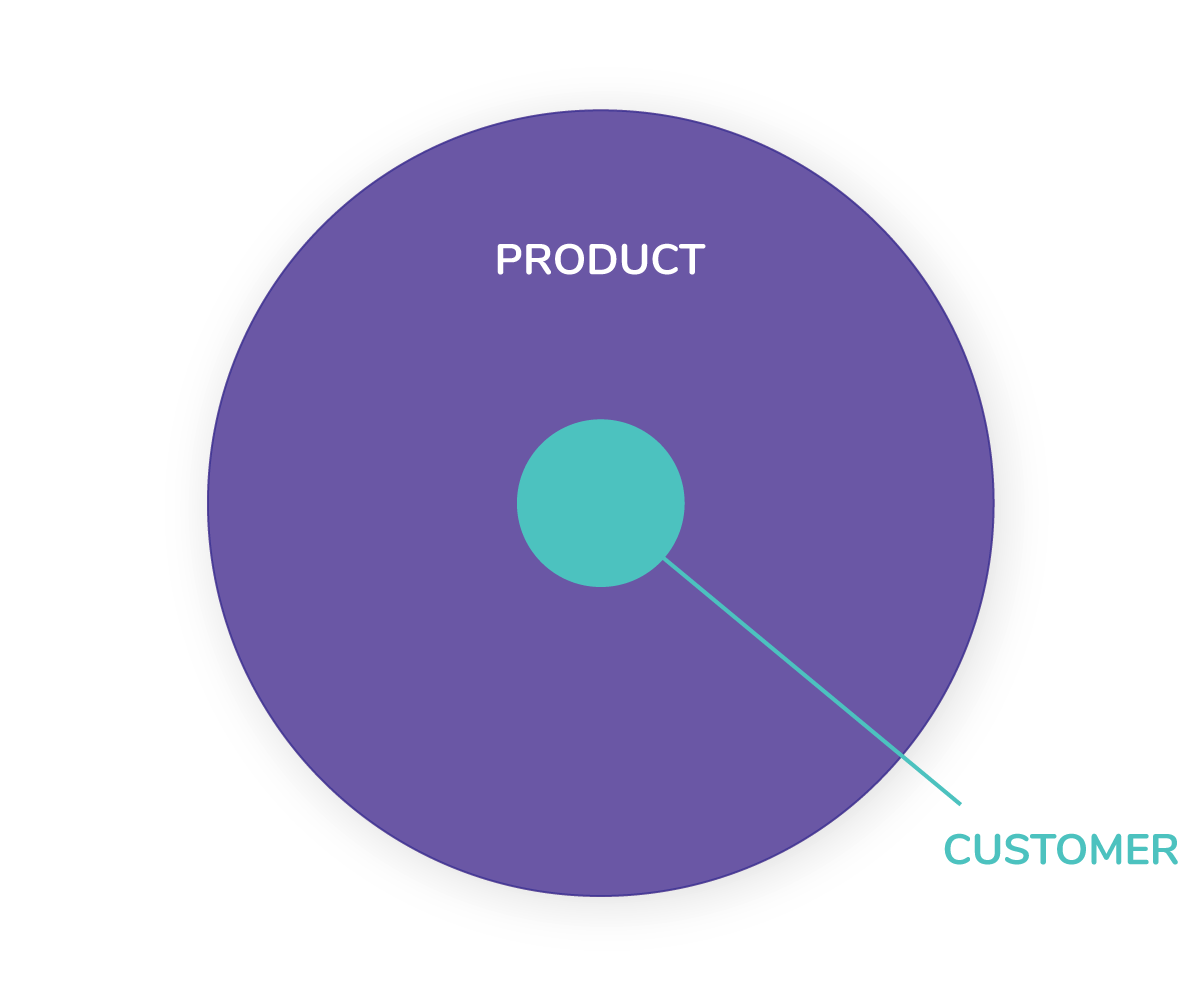
Once it’s established that your product is inherently customer-centric, then putting the product at the center of the customer experience makes a lot of sense. Your product is the means through which your customer will realize value.
A SaaS marketing approach requires putting the product at the center where marketing, sales, and customer success intersect.
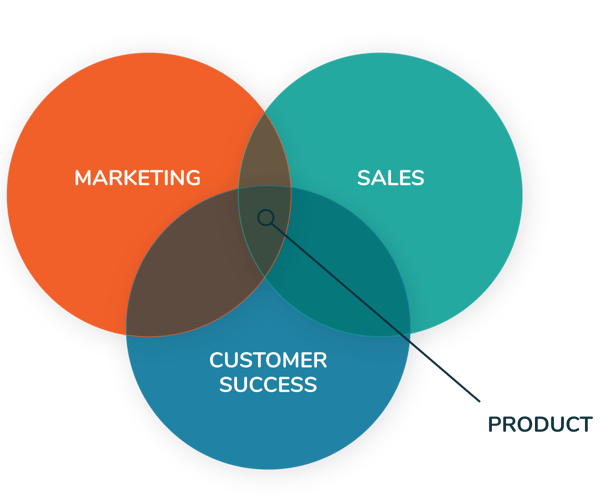
A SaaS company’s primary focus has to be on helping the customer be successful by using the product. And all these areas have specific roles to do that:
Many non-SaaS companies survive and are even successful working in silos.
SaaS, however, is not that forgiving.
SaaS companies must continue to deliver on the value proposition and support the customer throughout the entire lifecycle.
You need to have an orchestrated approach to making your customers more and more successful. And this demands collaboration that goes well beyond aligning sales and marketing.
Meanwhile, your product—your customer-centric software and the solutions you offer around it—needs to be at the core of everything.
You also need continual feedback from customers about:
This is vital information that needs to translate into evolving marketing messages and ongoing sales enablement.
The price point and complexity of a SaaS product dictate the way in which customers buy it. And that dictates the go-to-market strategy.
Your go-to-market strategy has to support the way your customer wants to buy.
If you’re selling a SaaS product with total annual contract values (ACVs) under $10k, you may be targeting small and midsize businesses (SMBs). A purchase of this level will undergo a light- to medium-scrutiny buying process.
In this type of purchase, you’ll be mostly selling directly to users. Although they may ask a few questions before making a decision, the decision is still relatively quick.
The main intention of users during the buying process is to make sure the product can fulfill the need for which it’s being bought.
Therefore, the main question to answer to support the buying process is: “Can this product successfully solve my problem?”
On the other hand, when you’re selling SaaS solutions with ACVs above $10k, ranging all the way to six or seven figures, you are targeting mid-market to enterprise businesses.
There is a high to extremely high risk associated with a purchase of this caliber, so the purchase process will undergo a high-to-intense scrutiny buying process.
You’ll be selling to buyers and decision-makers, or to an entire committee of them.
Before arriving at a consensus and making a final decision, they’ll be asking dozens to hundreds of questions during the buying process. This demands an orchestrated, multi-tiered approach to marketing and sales.
There will be a larger number of requirements associated with the purchase.
However, all questions will revolve around these central concerns: “How can I make sure I’m making the right decision, and how can I reduce the risk for me and my organization?”
| Low-touch | Mid-to-High Touch | |
|---|---|---|
|
ACV |
~ few dollars to $10k |
$10k’s - $100k’s+ |
|
Selling to |
Individuals and SMBs |
Mid-market to enterprise |
|
Scrutiny level |
Low to medium |
High to intense |
|
Market to |
Users |
Buyers |
|
Buying cycle |
Minutes to hours |
Weeks to years |
|
Selling strategies |
Product-led-growth |
Sales teams |
|
Questions to answer during the buying process |
1-20 questions |
Dozens to hundreds |
|
Buying process theme: |
Will I be successful solving my problem with your product? |
How can I make sure I’m making the right decision / reduce risk for me and my organization? |
|
Revenue dynamics |
High volume of transactions; low value per transaction |
Low volume of transactions; high value per transaction |
|
Success factors |
A great trial / freemium experience; low risk perception |
POCs, phased implementation approaches, support, consulting, pilot programs, arriving to decision makers faster than the competition, etc. |
Though the above touch categories are simplified, they demonstrate just how important SaaS-specific strategies are to effective marketing. And nowhere is this more important than in the SaaS sales funnel.
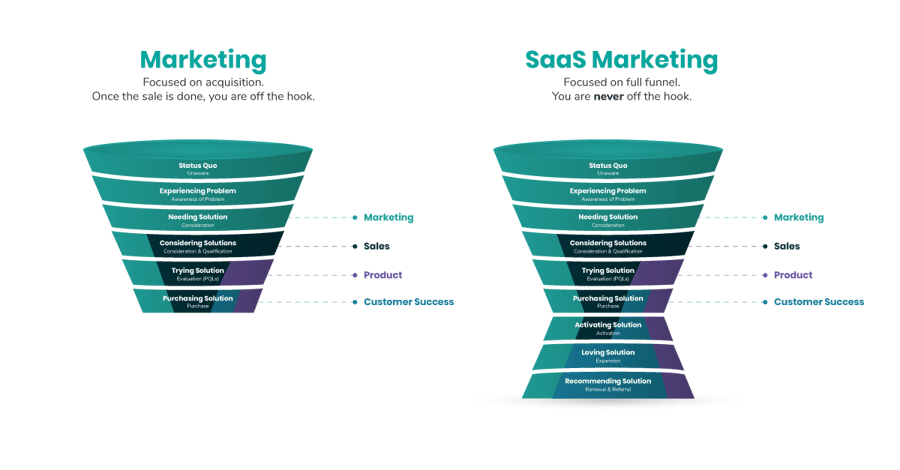
Conventional marketing typically stops at the evaluation process. In some cases marketing can extend all the way to the execution of the sale.
But as the diagram shows, that approach ignores an entire half of the SaaS sales funnel—which includes renewals, expansions, and referrals!
That’s why SaaS marketing must take a full funnel approach where the post-activation stages are considered just as valuable as the top funnel elements.
You cannot stop marketing to existing customers. If you do, you may be missing sales opportunities, suffering from poor activation rates, and enduring unnecessarily high churn rates.
In SaaS you must continue to engage your customer base.
A lot of SaaS companies stop marketing after customers have requested a free trial or demo.
But why? That kind of strategy enables valuable opportunities to wither—rather than thrive.
Successful SaaS companies such as Slack and Atlassian dedicate entire teams to marketing in the post-activation stage with essentially one message: “How can we help you continue to be wildly successful using our product?”
Why is that important?
Think about it like this: When you’ve already paid for the marketing, promotion, education, etc., needed to get that lead to request a free trial, they now become the most expensive lead to lose.
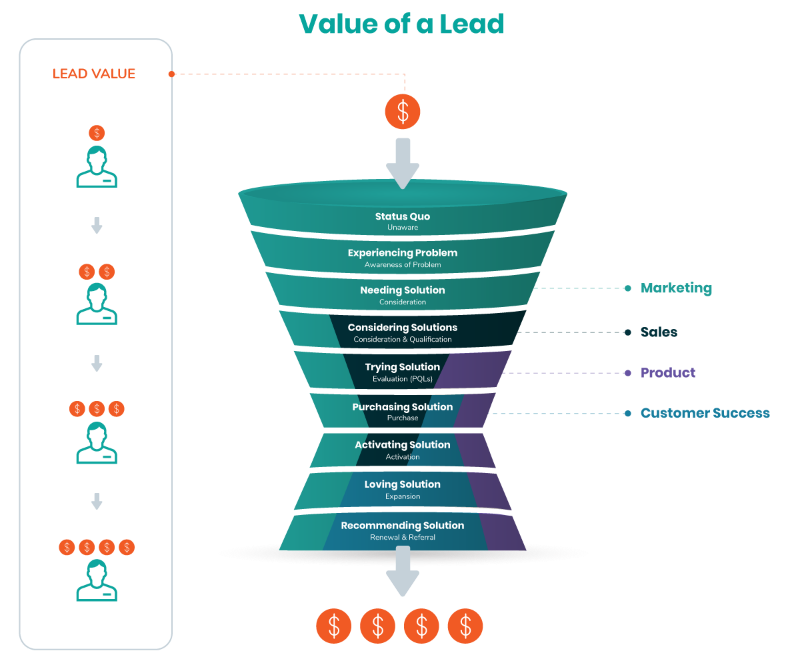
Yet it's not uncommon for the conversion rate of trial-to-paying users to be in the low single digits.
In fact, the biggest drop in the entire funnel can occur at this point.
Sure, there can be a variety of reasons for a low conversion rate. But when you stop marketing at the trial phase, you’re definitely not helping your conversion opportunities.
Since SaaS companies rely on recurring revenue, you need to keep on communicating your product’s story to your customers.
Marketing in essence never stops, and your post-activation efforts must focus on helping the customer be as successful as possible with your product.
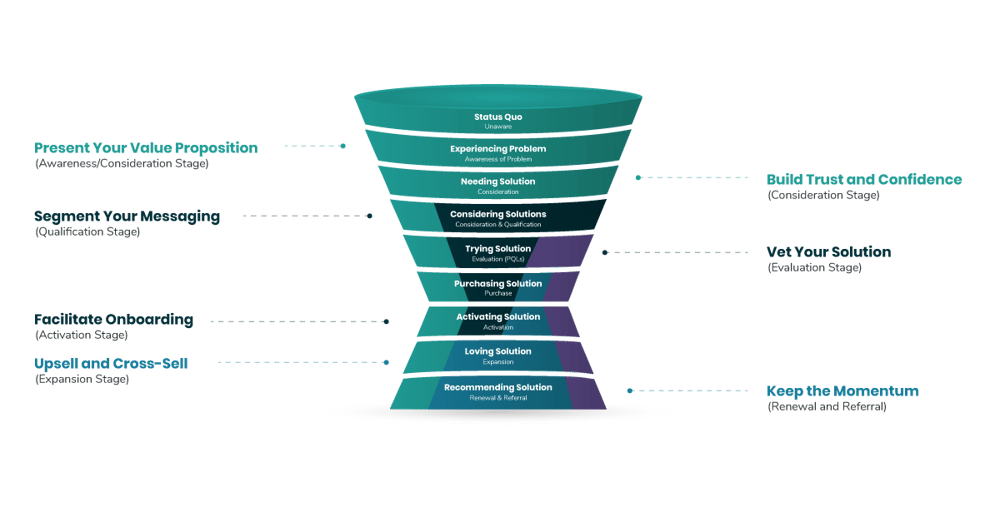
Consider the diagram above: Every stage requires specific tactics and strategies. That’s because the needs of your customers change as they advance in the SaaS lifecycle from leads to activation to renewal and beyond.
Note that the diagram reflects a high-touch funnel. A low-touch funnel is similar but involves less stages at the upper level because the risk factor is lower.
Past the activation phase, communicating the value of your software throughout the lifecycle becomes critical. The customer might have made a purchase to solve one particular challenge.
But it’s now your job to show all of the additional value that the customer could extract from the software—and multiply its impact.
At the top of the funnel, you’re helping to clarify not just what the problem is but what life can be like after it’s solved. Make sure that you:
You're making the case for why your product is THE choice, backed by data and social support. You’ll need to:
You likely have multiple audiences. Make sure you’re getting the right messages to each:
It’s time to instill confidence in your customer that they’re making the right decision and prove that your solution works. Take steps like:
This the most critical stage in the entire funnel.
A smooth activation process will secure a new customer, while a bumpy activation process will put the new deal at risk.
Here you need to do everything possible to help your customer realize value quickly and help them experience your product’s benefits ASAP.
Use a combination of automated and guided expert support:
Deliver support and help your customers solve problems quickly:
Seize opportunities after the customer has been onboarded by focusing on tactics like these:
When defining the ultimate metric to guide your SaaS, the highest bar you can possibly set is in maximizing your referral rate.
If you can get your customer base to refer you to new prospects, that’s beyond measuring the intention with net promoter score (NPS); it’s actually the referral.
Engaging in activities that maximize your referral rate involves more than just improving conversions at those touchpoints.
In the most basic sense, maximizing referral rates requires high customer satisfaction. At this stage, you need to make sure you:
Another key difference between conventional marketing and SaaS marketing is how companies approach creating a brand identity.
Traditional branding companies may obsess about how to make the brand look better.
Unfortunately, they typically do this in complete isolation of the product or service being offered.
That does not work with SaaS because the essence of the customer experience—i.e., the user experience (UX)—occurs directly with the product itself.
That’s why it is so imperative to create a cohesive customer experience—from the first touch (which will likely be digital) all the way through the entire experience of the product.
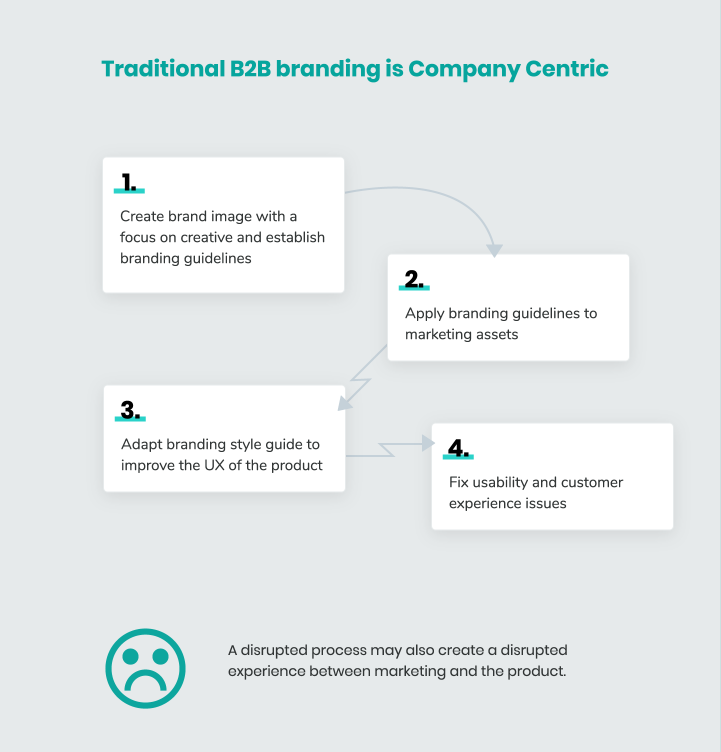
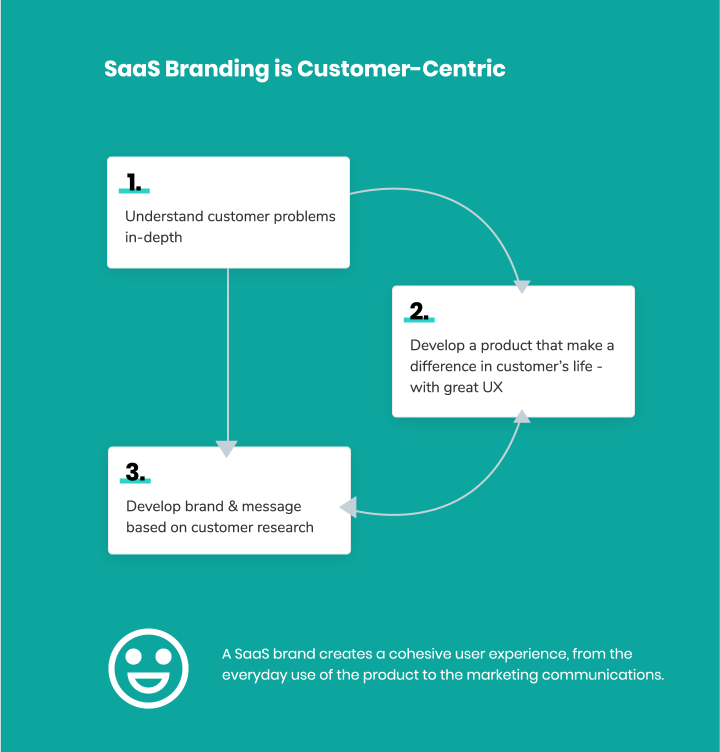
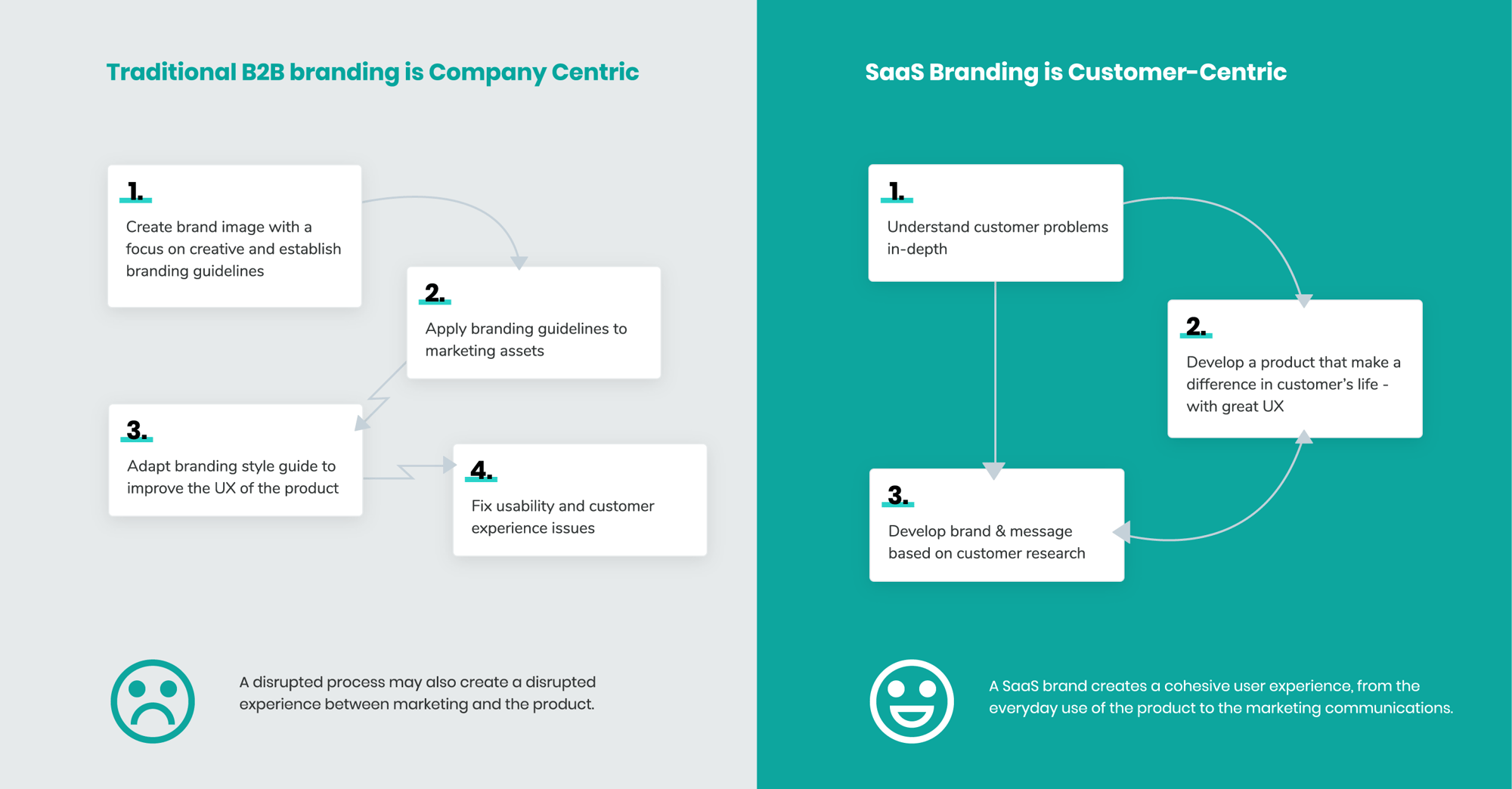
In other words, a SaaS approach demands that the software and the customer experience are integral to the branding process.
They comprise a feedback loop that involves:
A final—and critical—point on SaaS branding is this: Ideally, the process should start with the UX of the product.
Remember, the experience of the brand ultimately occurs within the actual product. Therefore, providing an excellent UX of the product should take precedence.
That great UX should then be extended to the marketing and sales realm.
Your SaaS business depends on having enough customers consistently use your product over a long period of time. And the more the lifetime value, the better.
That’s why it’s mission-critical to make the experience of the product the best you can.
A great-looking website and captivating marketing materials are just not going to be enough if they bring potential customers to a product with a terrible user interface.
You’ve just taken your company to the post-revenue stage.
Your primary goal is simple but critical: Create an initial group of satisfied clients—clients that form the basis for testimonials and other social proof. You’ll need to:
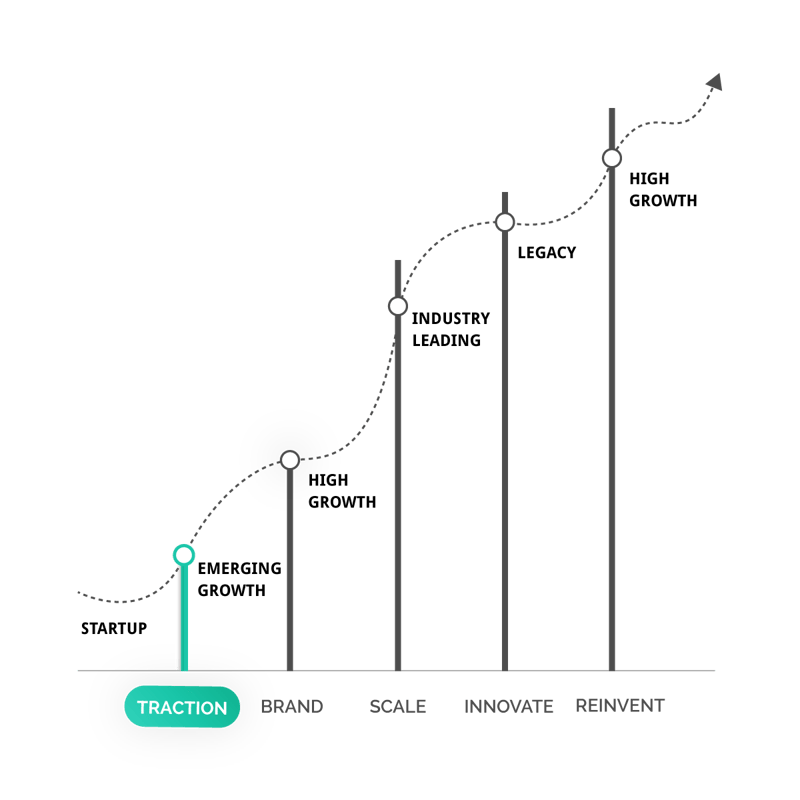
Now you’re looking to build your growth engine. Steps to take include:
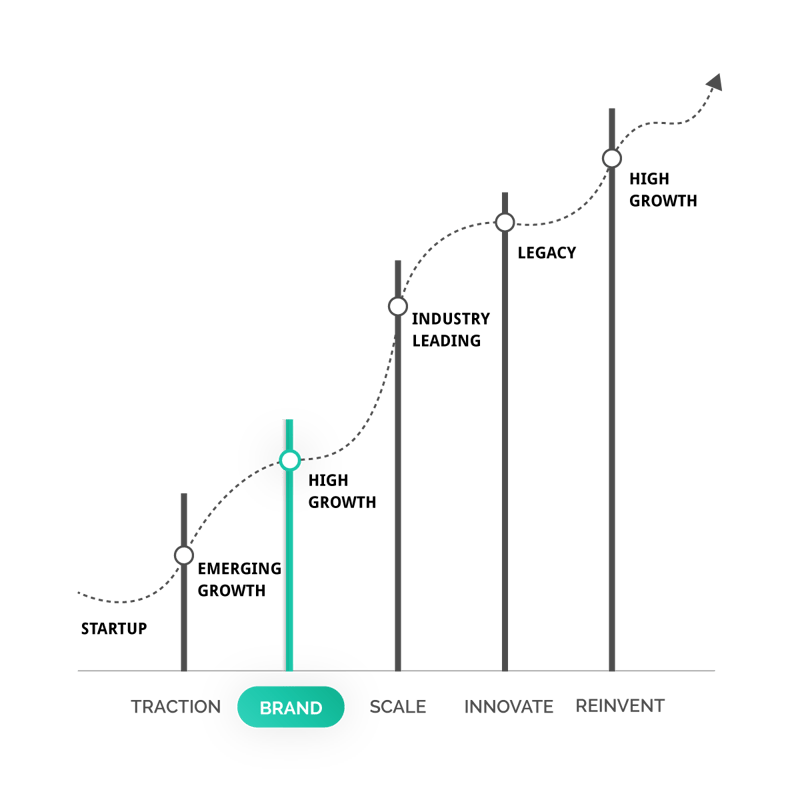
Now you need to scale. Your marketing efforts must kick into high-gear:
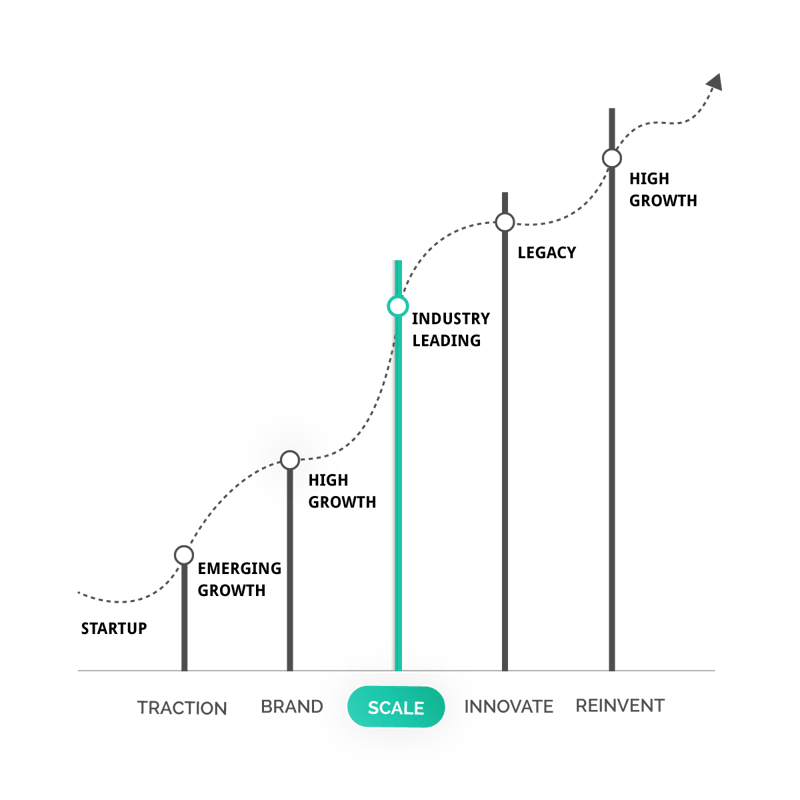
SaaS companies and other recurring revenue businesses realize the economic value of new customers over a long period of time.
According to David Skok, the following metrics are the most critical for a SaaS business, and both are deeply influenced by SaaS marketing:
There are two derivative measures that are important in determining the health of a SaaS business:
With these data, a SaaS company can get an idea of the overall performance of the business. And your marketing performance will have an impact on every single one of them.
Establishing a robust SaaS marketing approach requires you to formulate a number of other measurements. These relate to the funnel performance metrics:
One note on that last bullet: Getting a handle on these invites will give you an overall idea of the funnel performance of the business and give your team insight on where to focus improvement efforts.
All metrics are important, but what data rank the highest in priority and potential impact?
To get insights to improve a particular part of the funnel, you’ll need to establish more granular metrics dashboards. A few worth defining include:
Create an overview of the performance of marketing and sales efforts to bring in new customers by including SEO, SEM, website, email, and throughput performance.
Keep a close look at the activation funnel. Leads who have requested a trial or a demo are the most valuable; hence, it’s critical to get a clear picture of the funnel conversion performance between trial/demo and activation.
These should include retention, expansion, and renewal metrics by segment; key feature adoption rates; and engagement with the SaaS product by market.
Also, you’ll want to conduct cohort analysis to correlate improvements in onboarding and product marketing tactics with success in retaining and upgrading customers.
Market 8 is 100% focused on helping SaaS firms establish their brand and sell more software.
We help B2B SAAS companies sell more software by optimizing their entire funnel, from lead capture to renewals.
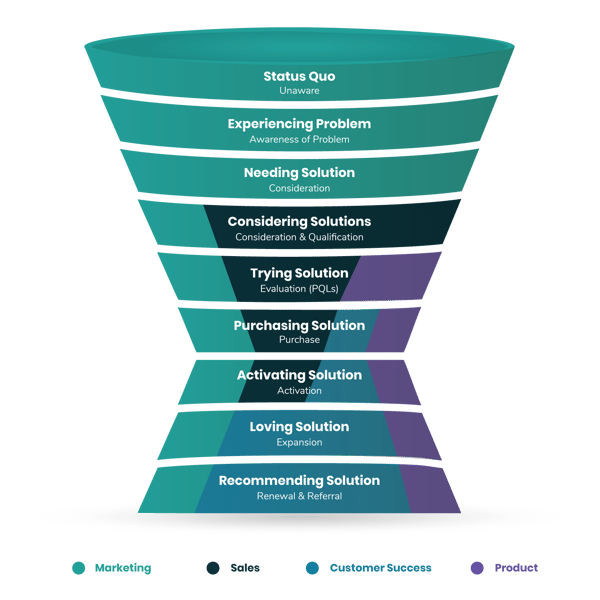
Unlike most “full service” agencies, we dive deep to learn all about your SAAS product.
How?
We ask informed questions (a lot of them!) about your customers before prescribing anything.
That means every decision—from branding to marketing growth plans to sales tactics—is based on real data, not assumptions.



From startups to enterprise software firms like Siemens PLM -- we’ve improved conversion performance for companies of all sizes.






We’ve been widely recognized for helping clients achieve success. In 2016, Market 8 received two Grand Prize Impact Awards for Inbound Client Growth Story and Happiest Customers, as well as nine Hermes awards, including four Platinum B2B website awards.
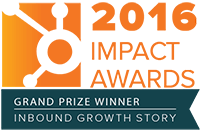
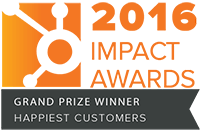
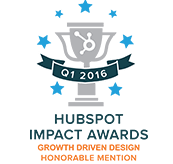
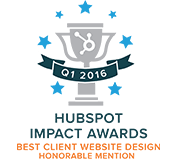
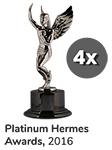
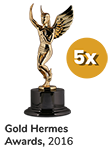
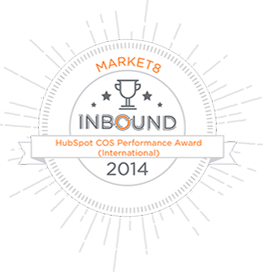
A key part of success: become a certified expert

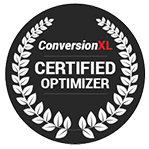

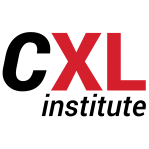



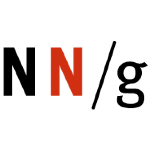




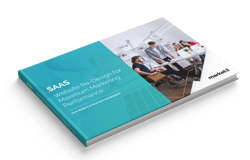
If you are looking into redesigning your SAAS website, there is one major thing that you need to consider: Your website is your best salesperson at every stage of your SAAS customer lifecycle.
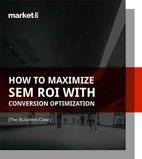
If you are spending money on SEM, it makes sense to maximize more than impressions and click-thru-rates; maximize your lead generation.
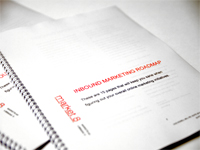
Marketers hear the same terms constantly, “target your audience,” “reach your customers,” “build your brand,” etc. Most marketing plans bring effective results but many fall short of their goals.